 HOME: www.hiltonpond.org |
|||
|
RUFOUS HUMMINGBIRD |
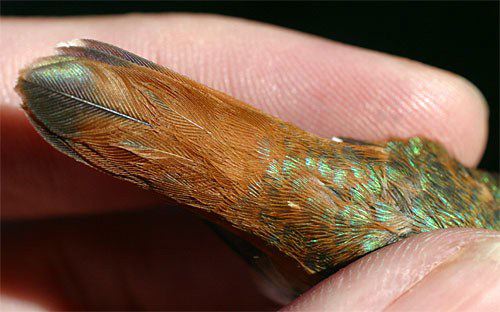
All text & photos © Hilton Pond Center There are places in the Carolinas that host western vagrant hummingbirds on a regular basis--yards where species such as Rufous Hummingbirds show up in successive winters. No one really knows why this happens, but if a hummer's migration path is an innate trait--which it must be because young birds make their first southerly migration without guidance from their elders--then perhaps wandering western hummers genetically pass on their tendency to wander, or even to end up at specific places. We first met the Blankenships in November 2000, when they contacted the Center about a hummer visiting their feeder in Pendleton SC, not far from Clemson University. To make a long story short, we traveled to Pendleton, trapped the Blankenship bird, and identified it as a first-year female Rufous Hummingbird. Interestingly, the Blankenships had also hosted a Rufous the preceding winter--an apparent young male that was not captured or banded. Last year, Buren answered a pulpit call for a new church in Columbus (Polk County) NC, just off I-26 and barely over the state line from South Carolina. He moved into the parsonage and wife Luanne--an accomplished master gardener--began putting in nectar plants around their new home. Among her plantings were several sages (especially Tall Blue, Pineapple, and Red), Lantana, Cleome, and Verbena. The blossoms attracted numerous butterflies and Ruby-throated Hummingbirds during the summer but the Blankenships wondered if they'd ever get a winter vagrant hummer.
Their speculation ended on 6 October 2003 when a hummingbird with a bright rusty tail showed up and started dining from the sages. The bird--an apparent first-year male Rufous Hummingbird--staked out the Blankenship backyard as his exclusive territory, chasing everything from Tufted Titmice to Eastern Chipmunks. Despite the presence of two sugar water feeders, the hummer spent all his time in flowers during the first week but eventually started supplementing his natural nectar diet with regular hits of 1:4 sugar water mix. On the evening of 19 October-- when Luanne was finally satisfied the hummer was accustomed to the artificial food source--Buren sent us an e-mail and we replied immediately with a plan to drive the 75 miles from Hilton Pond to Columbus NC the very next morning.  We arrived at the Blankenship residence at 6:45 a.m., well before dawn and with plenty of time to set up our portable hummingbird trap in the spot where a feeder was hanging. After placing the feeder inside the trap, we nestled the contraption amongst the Lantana and waited for our quarry to show up. At 7:15 a.m. when the sky was barely light, Buren heard the chittering of a hummingbird and--sure enough--one zoomed in. Almost invisible in the twilight, it perched in the Lantana for a few minutes, flew to and drank from numerous sage blossoms, and then disappeared. Over the next hour the hummer returned a few times and followed the same pattern. Only once did it even fly near the trap, but as the light got better we could easily see its green back and bright rusty tail and rump--almost surely making it a young male Rufous Hummingbird, Selasphorus rufus.  During the next 30 minutes the hummer made even fewer visits. It still ignored the feeder in the trap but made a couple of inspections of the eaves, where a second feeder had hung until the Blankenships took it down the night before in anticipation of our visit. After another half hour of not seeing the bird at all, we tried to think like a hummingbird and moved the trap from the Lantana to the eaves. Still no hummer. Finally, at the 145-minute mark, the hummer returned and flew directly into the trap. Without hesitation, we pushed the button that let a door slide shut behind him, thus snaring the hummingbird and providing a much closer view.
When we asked Buren if his being a man of the cloth had anything to do with all these vagrant hummingbirds coming to visit various Blankenship residences, he ruled out divine intervention and concluded it probably had a lot more to do with Luanne's faithful planting of hummingbird flowers--something we most certainly need to do more of at Hilton Pond Center. Age/Sex--Hatch year male Weight--3.60g Wing Chord--40.1mm Tail Length--26.0mm Tail Fork--4.0mm Culmen (upper bill)--16.5mm Bill Corrugations--Full length of bill, some smoothing on upper edge Gorget--Five orange-red metallic feathers
POSTSCRIPT: While we were waiting for the Blankenship's Rufous Hummingbird to enter the trap, we got a brief glimpse of a rather chunky hummer with a green back and white throat visiting some of the flowers. Luanne and Buren had seen this bird for several days previously. Although it looked a lot like a Ruby-throated Hummingbird, 20 October would be very late for this species--especially in the higher foothills of North Carolina. We weren't able to stay around for additional observations, but if this second bird lingers on past a hard frost that kills the nectar plants it will be much easier to trap and identify on a return trip to see our Blankenship friends in Columbus NC.
If you're interested in sharing your hummingbird observations and learning from other enthusiasts, you may wish to subscribe to Hummingbird Hobnob, our Yahoo!-based discussion group. Also be sure to visit our award-winning Web site for Operation RubyThroat: The Hummingbird Project; on it you'll find almost anything you want to know about hummingbirds, including more information about Hummingbird Banding.
For much more information about hummingbirds, visit Operation RubyThroat: The Hummingbird Project  |
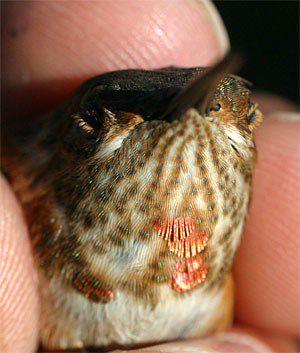 This could account for why here at Hilton Pond Center we banded a young female Rufous Hummingbird in 2001 and then a young male in 2002--perhaps a mother- son link. It doesn't explain, however, the story of Buren and Luanne Blankenship, who seem to host winter vagrant hummers wherever they go.
This could account for why here at Hilton Pond Center we banded a young female Rufous Hummingbird in 2001 and then a young male in 2002--perhaps a mother- son link. It doesn't explain, however, the story of Buren and Luanne Blankenship, who seem to host winter vagrant hummers wherever they go.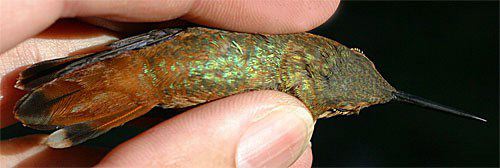
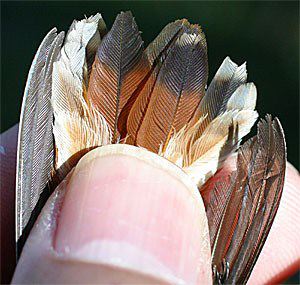 The presence of heavy throat streaking and rusty tail and rump confirmed this was indeed a male. Its incomplete gorget and tiny etchings on the bill indicated it was a bird hatched in 2003, and its tail feathers were so wide it ruled out the possibility of it being an Allen's Hummingbird (a closely related and similar-looking species). It was Rufous Hummingbird #3 for the Blankenships. We banded the hummer and photographed it, after which Buren--who deferred to his wife at their last banding party--got to hold and release the bird while Luanne took lots of pictures.
The presence of heavy throat streaking and rusty tail and rump confirmed this was indeed a male. Its incomplete gorget and tiny etchings on the bill indicated it was a bird hatched in 2003, and its tail feathers were so wide it ruled out the possibility of it being an Allen's Hummingbird (a closely related and similar-looking species). It was Rufous Hummingbird #3 for the Blankenships. We banded the hummer and photographed it, after which Buren--who deferred to his wife at their last banding party--got to hold and release the bird while Luanne took lots of pictures.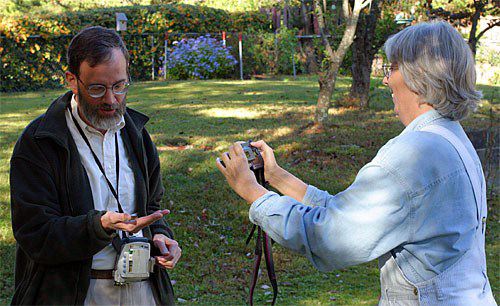

 Students at GLOBE-certified schools may submit winter hummingbird observations as part of Operation RubyThroat and GLOBE. Students can also correlate hummingbird observations with data on abiotic factors, including atmosphere, climate, hydrology, soils, land cover, and phenology. See the
Students at GLOBE-certified schools may submit winter hummingbird observations as part of Operation RubyThroat and GLOBE. Students can also correlate hummingbird observations with data on abiotic factors, including atmosphere, climate, hydrology, soils, land cover, and phenology. See the 


